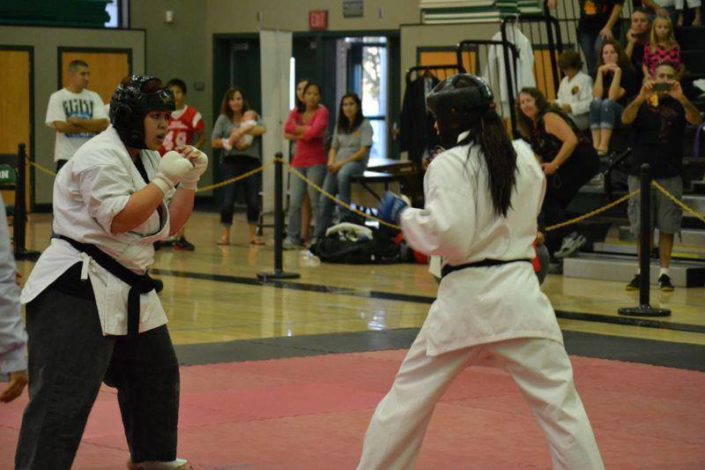Knockdown Karate, or Jissen Kumite, is a tough martial arts sport brought to a high level of popularity in the 1960’s by Masutatsu Oyama and his Kyokushinkai organization in Japan. Oyama Sensei organized his First International Open Kyokushin Karate Tournament in Tokyo in 1969. The popularity of full contact karate grew from this event, attracting the toughest karate fighters from all over the world, and showing up in movies and literature on an international scale. The knockdown / full contact karate community has remained faithful through the years and is growing in popularity due to its reputation for tough, real karate. Although not as well known as sport karate or other combat sports, top MMA fighters seek the knowledge and skills of knockdown/full contact karate to arm their stand up game with the most effective strikes.
Karate originated in Okinawa, as did the practice of full contact karate. Okinawan Karate basics include study of striking and blocking, and general body conditioning; karateka train to absorb and deflect blows to the legs, arms, and torso with minimal injury. Okinawan leg kicks and blocks are honed to a science, and among the most effective of all the martial arts. Numerous games and competitions have existed in Okinawa for hundreds of years where karateka target the opponents legs, and torso with unpadded kicks and punches. Small but serious full contact (Jisen Kumite) tournaments existed in Okinawa in the 1970’s and 80’s establishing Ryukyu full contact champions with little international notice. In 1992, the Shorinryu, Uechiryu and Gojuryu dojos from the islands forming the southernmost prefecture of Japan (the Ryukykus) joined together on Okinawa to form the All Ryukyus Full Contact Karatedo Association with their first president, Hanchi Koei Nohara of the Ryukyukan Karatedo Federation. The first All Ryukyus Karate Tournament was held that year in Okinawa, demonstrating the forms (kata) of the different Ryukyu dojos, kobudo, and Jisen Kumite (real combat sparring) fight competition. The All Ryukyus Tournament is a bare knuckle and bare leg full contact competition. No pads or protective devices except groin protector and tooth guard are allowed. Many karateka from all over the world have come to watch or compete in this tournament; all leave with a real respect for the toughness and technique of Okinawan karate. Hanchi Nohara hosts two other knockdown karate events each year through the Ryukyukan Karate Federation: One in Dixon, California, USA each November, and one in London, UK each April.
Most people in the US think of sport karate when they think of karate tournaments. Sport karate kumite (sparring) emphasizes technique, speed, timing, accuracy and control. If an athlete demonstrates a technique which would injure or disable a real opponent, he or she scores a point. Too much contact is penalized. This is a popular and effective way to practice a real fight situation, especially the situation of who strikes first and most accurately. The Ryukyus introduced Karate to mainland Japan in the early 1900’s. Sport karate kumite was invented in mainland Japan and shipped back to the Ryukyus nearly 50 years later. Sport karate kumite is not considered to be part of the origional karate (Okinawa Te).
Full Contact / Knockdown Karate is more deeply rooted in the historical karate of the Ryukyus. Like sport karate, full contact karate is a sport which also strives to determine who would be victorious in a real fight situation, but uses a different criteria: Punches and kicks that cause the opponent to buckle or fall are scored, techniques which do not produce an effect do not score. Full contact kicks using the foot, shin, and sometimes knees can be delivered to the legs, torso, and head. Full power punches can be delivered to the body only. Karateka train severely for years to prepare for full contact karate competition. With the proper preparation, full power karate blows can be deflected, evaded, or absorbed without damage to the receiver. Those who do not prepare correctly for Okinwan style leg kicks end up on the floor in short order. Karateka who wish to to test their ability to deliver blows which actually buckle or knock down an opponent, while withstanding full power attacks are attracted to full contact karate matches. Full contact karate matches require full commitment and effort by both contestants, which produces a great respect and camaraderie between participants. Anyone watching or participating in full contact karate gains a deep respect for the preparation and deep effort required; booing or poor sportsmanship is almost never seen or heard. Competitors as young as eight years old are joining the ranks of martial artists who practice full contact karate, mainly due to improved safety gear and safe tournament practices.








